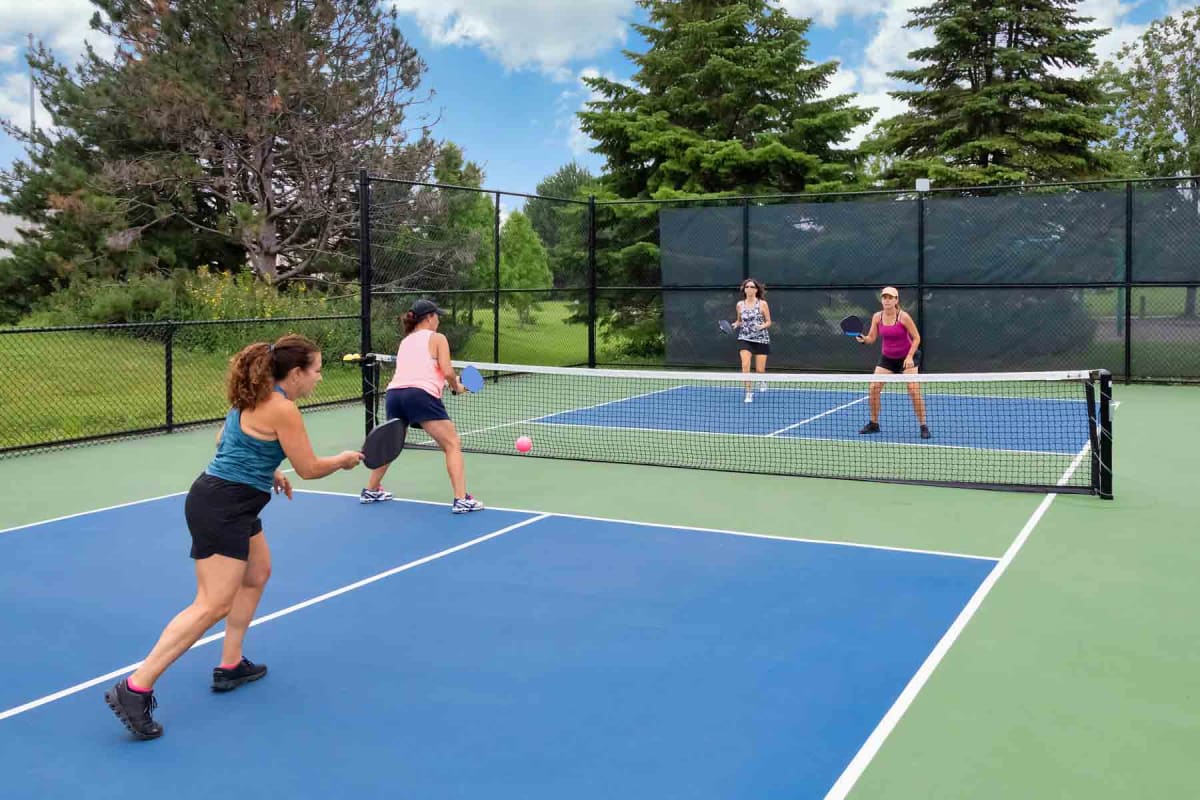Pickleball Court Construction Cost Overview-- What to Expect
Wiki Article
Sustainable Practices in Pickleball Court Building You Must Know
As the popularity of pickleball remains to rise, so too does the need for sustainable methods in court building and construction. This approach not just addresses ecological worries however additionally boosts the durability and functionality of the courts. From picking environment-friendly products to carrying out effective drainage and energy-saving lights options, there are numerous methods to think about. The influence of these techniques prolongs far past the court itself. Recognizing how each component adds to a much more sustainable future invites even more exploration right into the complex balance in between recreational development and environmental stewardship.Choosing Eco-Friendly Materials
Picking environment-friendly products is a vital action in the building of lasting pickleball courts. The option of sustainable materials not only decreases environmental effect but additionally enhances the durability and efficiency of the court. Key materials include recycled rubber for the surface area, which supplies outstanding resilience and shock absorption while drawing away waste from landfills.Furthermore, using in your area sourced products lowers transport emissions and supports regional economic climates. Pickleball court construction. For instance, utilizing indigenous hardwoods for fencing and seating can provide a lasting visual while making certain strength against the elements.
Including absorptive materials for court foundations can better contribute to sustainability by permitting all-natural water drainage and minimizing runoff. These choices not just secure local environments however likewise promote healthier play atmospheres.
Reliable Drainage Solutions
While the option of environment-friendly materials is crucial, executing reliable drainage options is equally essential for maintaining sustainable pickleball courts. Correct drain not just protects the court surface from water damages but likewise lessens disintegration and drainage, advertising ecological honesty.Reliable water drainage systems can include permeable paving, which enables water to infiltrate the ground as opposed to pooling externally. This decreases the probability of standing water, which can bring about mold and mildew and various other upkeep issues. Additionally, integrating purposefully placed drain networks and swales can direct excess water far from the court area, making certain a completely dry playing surface and stopping dirt disintegration.
Making use of indigenous vegetation in the landscape design around the courts can better boost drain by taking in excess water and lowering drainage. These plants need less irrigation and promote biodiversity, aligning with lasting techniques.
Additionally, it is vital to consistently maintain the water drainage system to guarantee its long-lasting effectiveness. This consists of clearing up particles and monitoring for clogs. By prioritizing efficient drainage options, pickleball court constructors can dramatically add to the sustainability and durability of the center, ultimately profiting both players and the setting.
Energy-Efficient Lighting Options
As the demand for pickleball proceeds to grow, incorporating energy-efficient illumination alternatives into court layout has become increasingly essential for sustainability. Conventional lighting systems often take in extreme power, adding to greater functional costs and environmental effect. Therefore, embracing contemporary, energy-efficient modern technologies is essential for both new buildings and restorations.LED (Light Emitting Diode) lights stands out as a premier selection as a result of its durability and energy savings (Pickleball court construction). Contrasted to traditional illumination, LEDs use about 75% less power and can last as much as 25 times longer, dramatically lowering upkeep expenses. Additionally, the directional nature of LED lighting lessens light contamination, guaranteeing that lighting is concentrated on the court as opposed to surrounding locations.

Sustainable Surface Alternatives
Discovering sustainable surface area choices for pickleball courts has actually obtained grip among players and contractors alike. The emphasis on environment-friendly materials not only lines up with the growing environmental recognition yet likewise enhances the performance and toughness of the courts.One popular option is making use of recycled rubber, which can hop over to these guys be sourced from made use of tires. This product supplies superb shock absorption, reducing the risk of injuries for gamers while advertising sustainability. In addition, modular floor tiles made from recycled plastics offer another sensible alternative. These floor tiles are very easy to mount and change, and their versatility permits different court setups.
All-natural grass courts are also arising as a sustainable option, advertising biodiversity and decreasing the heat island impact. They need normal maintenance and water, which might not align with all sustainability objectives.

Water Preservation Methods

An additional effective strategy includes the installation of rain harvesting systems. These systems gather and save rain for use in keeping court surfaces and landscape design. This approach not only preserves potable water but likewise reduces dependence on local sources.
In addition, utilizing drought-resistant landscape design around the courts is vital. Indigenous plants require less water and are better adjusted to neighborhood climate conditions, therefore lowering overall water usage. In addition, utilizing efficient this article irrigation systems, such as drip irrigation, guarantees that water is provided directly to plant origins, minimizing evaporation and waste.
Conclusion
Including sustainable practices in pickleball court construction substantially adds to ecological conservation and resource efficiency. Making use of eco-friendly materials, executing efficient drain options, and taking on energy-efficient lights choices can significantly minimize eco-friendly effect. Exploring lasting surface area alternatives and using water conservation strategies enhance the overall sustainability of these recreational facilities. By focusing on these methods, the construction of pickleball courts can align with wider ecological objectives while promoting durability and performance within communities.As the appeal of pickleball proceeds to climb, so also does the demand for lasting methods in court building and construction.Picking eco-friendly materials is a vital action in the building of sustainable pickleball courts. By prioritizing energy-efficient lights alternatives, pickleball court builders can add to a much more sustainable future while meeting the needs of stakeholders and players alike.Including sustainable surface choices not only enhances the efficiency of pickleball courts however also leads the method for executing effective water preservation methods.Incorporating lasting methods in pickleball court construction dramatically adds to environmental conservation and resource effectiveness.
Report this wiki page